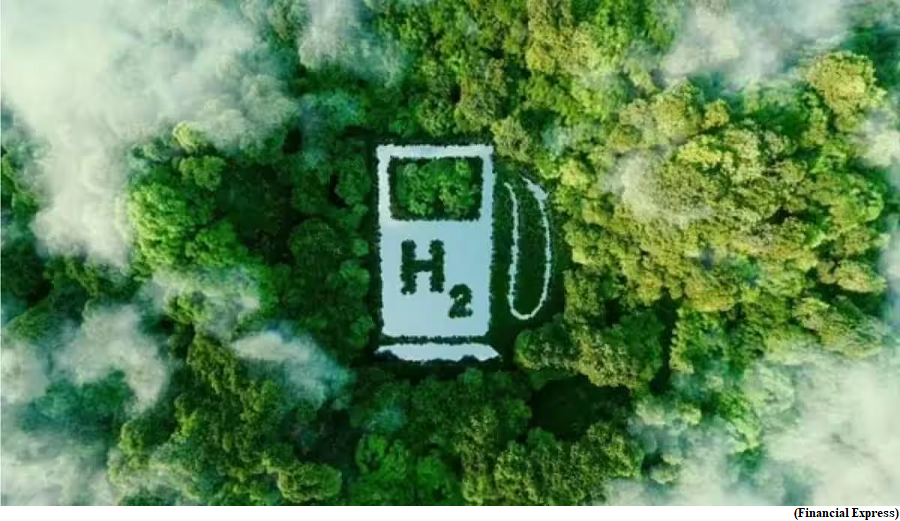Green hydrogen needs concessional finance (GS Paper 3, Environment)

Context:
- The government announced in June that it will allocate $1.6 billion for green hydrogen production and $0.5 billion for domestic manufacturing of electrolyser, a key link in the green hydrogen supply chain.
- With the government pitching in with just $2.25 billion, mobilising the quantum required ($200 billion) will need collective efforts.
Scope of Green hydrogen:
- Green hydrogen (GH2) is fast emerging as a winner in the race to become an energy-transition solution. This transition will entail investments worth $20 trillion by 2050.
- India’s National Green Hydrogen Mission (NGHM) is expected to play a pivotal role in propelling the country towards achieving energy independence by 2047 and Net Zero by 2070. It can contribute towards achieving technological sovereignty.
- NGHM aims to generate 5 million tonnes per annum (mtpa), with an investment of $200 billion by 2030 with an outlay of just $2.25 billion by the government.
Challenges in Giga-scale GH2 projects:
- Giga-scale GH2 projects are complex and yet to be executed in India. Currently, the technology maturity and commercial viability of the constituent elements remain to be verified.
- Considering the present costs associated with obtaining reliable, clean energy, seawater treatment, and electrolysers, the production of GH2 is costlier than grey-H2.
- The shortfall of cost-efficient transportation & storage infrastructure like pipelines/liquefication facilities/GH2 cascades linking the production & consumption centres must be bridged. Alternatives of using ammonia or other fuel carriers for shipping may become viable but are not fully established at this stage.
- The use-cases/application portfolio of GH2 has some more distance to go before it can stand the test of scale and technology maturity, as demonstrated in the present state of fuel cells & green steel/cement sectors.
- Moreover, many early-stage investors flag that the lack of a clear and consistent “green-premium” monetising regime for GH2 limits their willingness and ability to make strategic commitments to the sector.
Key Concerns:
- A recent collation of investors’ perspectives by the European Investment Bank on stimulating investment for the GH2 sector identifies the risks emanating from fluctuating offtake prices, mismatch in the duration of offtake commitments (typically 5-7 years at a time) vis-à-vis life cycles of GH2 manufacturing assets (about 25 years), industrial cycles dictating offtake volumes, and operational risks related to efficiency and reliability of GH2 equipment as key concerns.
- In the Indian context, potential delays in land acquisition, environmental clearances, and construction of GH2 facilities, liquefaction plants, and pipelines are also relevant. Due to the lack of an integrated framework for demand generation, there are no predictable revenue streams.
- Presently, there are limited consumers in India who enter into bespoke offtake agreements to buy H2 at non-transparent price points. All these dynamics make green hydrogen risky from the perspective of commercial financers.
Roadmap:
- In this early stage of development, public sector grants and other forms of concessionary funding will be a critical source of project financing until sufficient private sector funding sources are available.
- Blending public and private capital is key to making green hydrogen projects bankable and commercially viable. Multilateral Development Banks (MDBs) and Development Financial Institutions (DFIs) can fund projects, even if the economics are uncertain or the risk is high. They can offer concessional debt capital or equity capital to improve the risk-return profile of individual investments.
- The concessional capital can bridge the existing financing gap and consequently create a market. As the GH2 projects mature and investors are willing to participate, DFIs and MDBs can exit from their equity investments.
- Investors across the globe have expressed their demand for creating a level playing field by pronouncing the long-term government strategies on topics like ‘carbon levy.’ Such a measure can ascribe a value to the negative impacts of non-GH2 products/processes.
- Moreover, lack of clarity on ‘additionality requirements’ that take an integrated view of clean energy and GH2 sectors, silence on standards for health, safety, and environment (HSE), and a lack of synchronous policy frameworks between India’s key trading partner countries are some of the teething concerns dampening the investor sentiments.
Way Forward:
- India can break the vicious cycle of financial paucity for its GH2 initiatives by introducing volume- and price-based incentives for providing an early stimulus to the ecosystem. Such frameworks can bridge viability gaps to create a conducive environment for green entrepreneurs as the country undergoes a clean energy transition.
- It can improve the access-to-finance for high-potential indigenous GH2 innovations by crafting GH2 financing mechanisms within its flagship publicly funded programmes. Typical examples include setting up a dedicated innovation fund governed by an expert council for promoting GH2 projects.
- It can also leverage the National Investment and Infrastructure Fund to provide early-stage support to dedicated GH2 venture capital funds-led equity investments while topping it up with GH2-tailored advisory solutions.


